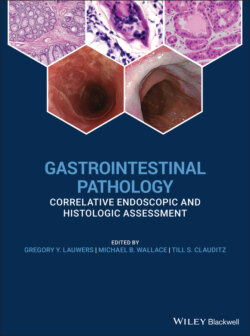Читать книгу Gastrointestinal Pathology - Группа авторов - Страница 78
Microscopic Features (Table 2.7)
ОглавлениеBiopsies most commonly show nonspecific esophagitis characterized by erosions, ulcers, active inflammation with neutrophils and occasionally eosinophils, surface epithelial damage, and granulation tissue. Adjacent mucosa is relatively normal. A careful search of the exudate and ulcer bed for refractile or polarizable foreign material is warranted, which may be an important diagnostic clue. However, in most cases the clinical history is necessary to make the diagnosis.
Some medications are associated with additional characteristic histologic features. Erosions and ulcers associated with doxycycline injury often exhibit a distinct capillary/vascular injury with degenerative changes and possible fibrin thrombi. In iron pill‐associated mucosal injury, bluish‐brown crystalline iron debris is found adjacent to the surface epithelium, admixed with the inflammatory exudate, or within granulation tissue (Figure 2.16). The iron can be highlighted by a Prussian Blue stain, which may also demonstrate crystalline debris in the lamina propria or underlying vessels. Although iron is well recognized as a caustic agent in the esophagus and elsewhere in the GI tract, some cases may represent secondary deposition in preexisting lesions. Alendronate has been associated with multinucleated squamous cells, in addition to the presence of polarizable crystalline material.
Figure 2.15 Endoscopic appearance of inflammatory stricture of the esophagus with sloughing mucosa.
Kayexalate (sodium polystyrene sulfonate) in sorbitol can be recognized by the presence of characteristic lightly basophilic, refractile, nonpolarizable crystals that display a mosaic pattern that resembles fish scales. The crystals can be highlighted by acid fast (black), PAS/Alcian blue and Diff‐Quik stains. Bile acid sequestrants (e.g. colestipol, colesevelam, cholestyramine) may be recognized by their orange‐black crystals, which lack a striated, fish‐scale appearance and may appear pale yellow on acid fast stain.
Mycophenolate, used in solid organ transplantation, is associated with increased apoptosis of esophageal squamous epithelial cells, resembling GVHD. Taxane‐based chemotherapy leads to striking mitotic arrest with ring mitoses, along with epithelial necrosis or ulceration.
